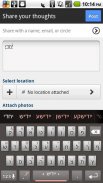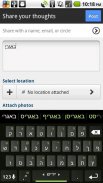




Yiddish Keyboard Plugin

คำอธิบายของYiddish Keyboard Plugin
Yiddish Dictionary plugin for Multiling O Keyboard autocorrect and word prediction
Instruction:
⑴ Install this plugin and Multiling O Keyboard. https://play.google.com/store/apps/details?id=kl.ime.oh
⑵ Run O Keyboard and follow its setup guide.
⑶ Slide space bar to switch languages.
If you have font issue, read this: <a href="https://www.google.com/url?q=https://www.google.com/url?q%3Dhttp://honsoapps.appspot.com/1/ma.html%26sa%3DD%26usg%3DAFQjCNG71Nl5i6QMcdEZvU1BqM2L70OWlQ&sa=D&usg=AFQjCNHJAfktVVilzCrduIwvK96EQvYRGw" target="_blank">http://honsoapps.appspot.com/1/ma.html</a>
Wikipedia:
Yiddish (ייִדיש, יידיש or אידיש, yidish/idish, literally "Jewish") is the historical language of the Ashkenazi Jews. It originated during the 9th century in Central Europe, providing the pre-existing language of the nascent Ashkenazi community with an extensive Germanic based vocabulary. Yiddish is written with a fully vocalized alphabet based on the Hebrew script.
The earliest surviving references date from the 12th century and call the language לשון־אַשכּנז (loshn-ashknez = "language of Ashkenaz") or טײַטש (taytsh), a variant of tiutsch, the contemporary name for Middle High German. In common usage, the language is called מאַמע־לשון (mame-loshn, literally "mother tongue"), distinguishing it from Hebrew and Aramaic, which are collectively termed לשון־קודש (loshn-koydesh, "holy tongue"). The term "Yiddish" did not become the most frequently used designation in the literature until the 18th century. In the late 19th and into the 20th century the language was more commonly called "Jewish", especially in non-Jewish contexts, but "Yiddish" is again the more common designation.
Modern Yiddish has two major forms. Eastern Yiddish is far more common today. It includes Southeastern (Ukrainian–Romanian), Mideastern (Polish–Galician–Eastern Hungarian), and Northeastern (Lithuanian–Belarusian) dialects. Eastern Yiddish differs from Western both by its far greater size and by the extensive inclusion of words of Slavic origin. Western Yiddish is divided into Southwestern (Swiss–Alsatian–Southern German), Midwestern (Central German), and Northwestern (Netherlandic–Northern German) dialects. Yiddish is used in a large number of Orthodox Jewish communities worldwide and is the first language of the home, school, and in many social settings among most Hasids. Yiddish is also the academic language of the study of the Talmud according to the tradition of the Lithuanian yeshivas.
The term Yiddish is also used in the adjectival sense, synonymously with Jewish, to designate attributes of Ashkenazi culture (for example, Yiddish cooking and Yiddish music).[4]
</div> <div jsname="WJz9Hc" style="display:none">ปลั๊กอินยิดดิชพจนานุกรมสำหรับ MultiLing O แป้นพิมพ์แก้ไขอัตโนมัติและการทำนายคำ
คำแนะนำ:
⑴ติดตั้งปลั๊กอินนี้และ MultiLing O แป้นพิมพ์ https://play.google.com/store/apps/details?id=kl.ime.oh
⑵เรียก O แป้นพิมพ์และปฏิบัติตามคำแนะนำการติดตั้งของ
แถบพื้นที่สไลด์⑶เพื่อสลับภาษา
หากคุณมีปัญหาตัวอักษรอ่าน: <a href="https://www.google.com/url?q=http://honsoapps.appspot.com/1/ma.html&sa=D&usg=AFQjCNG71Nl5i6QMcdEZvU1BqM2L70OWlQ" target="_blank">http://honsoapps.appspot.com/1/ma.html</a>
วิกิพีเดีย:
ยิดดิช (ייִדיש, יידישหรือאידיש, yidish / idish อักษร "ชาวยิว") เป็นภาษาประวัติศาสตร์ของชาวยิวอาซ มันเกิดขึ้นในช่วงศตวรรษที่ 9 ในยุโรปกลางให้เป็นภาษาที่มีอยู่ก่อนของชุมชนอาซตั้งไข่กับกว้างขวางดั้งเดิมตามคำศัพท์ ยิดดิชเขียนด้วยตัวอักษรก้องอย่างเต็มที่ขึ้นอยู่กับสคริปต์ภาษาฮิบรู
ที่เก่าแก่ที่สุดที่รอดตายอ้างอิงจากวันที่ศตวรรษที่ 12 และเรียกภาษาלשון-אַשכּנז (loshn-ashknez = "ภาษาของ Ashkenaz") หรือטייַטש (taytsh) แตกต่างจาก tiutsch ชื่อร่วมสมัยกลางเยอรมัน ในการใช้งานทั่วไปภาษาที่เรียกว่าמאַמע-לשון (Mame-loshn อักษร "ภาษาแม่") แตกต่างจากภาษาฮีบรูและอราเมอิกซึ่งเป็นที่รวมเรียกว่าלשון-קודש (loshn-koydesh "ลิ้นศักดิ์สิทธิ์") คำว่า "ยิดดิช" ไม่ได้กลายเป็นกำหนดที่ใช้บ่อยที่สุดในวรรณคดีจนกระทั่งศตวรรษที่ 18 ในช่วงปลายทศวรรษที่ 19 และศตวรรษที่ 20 ภาษาที่ถูกเรียกว่ามากกว่าปกติ "ชาวยิว" โดยเฉพาะอย่างยิ่งในบริบทที่ไม่ใช่ชาวยิว แต่ "ยิดดิช" เป็นอีกครั้งที่การกำหนดร่วมกันมากขึ้น
โมเดิร์นยิดดิชมีสองรูปแบบหลัก ภาคตะวันออกยิดดิชอยู่ไกลกันมากขึ้นในวันนี้ ซึ่งจะรวมถึงตะวันออกเฉียงใต้ (ยูเครนโรมาเนีย) Mideastern (โปแลนด์กาลิเซียตะวันออกฮังการี) และภาคตะวันออกเฉียงเหนือ (ลิทัวเนียเบลารุส) ภาษา ภาคตะวันออกยิดดิชที่แตกต่างจากตะวันตกทั้งสองโดยขนาดของมันไกลมากขึ้นและโดยรวมที่กว้างขวางของคำพูดของแหล่งกำเนิดสลาฟ ยิดดิชตะวันตกแบ่งออกเป็นทิศตะวันตกเฉียงใต้ (สวิสอัลเซเชี่ยนใต้เยอรมัน) แถบมิดเวสต์ (กลางเยอรมัน) และทิศตะวันตกเฉียงเหนือ (Netherlandic เหนือภาษาเยอรมัน) ภาษา ยิดดิชถูกนำมาใช้ในจำนวนมากของชุมชนชาวยิวออร์โธดอกทั่วโลกและเป็นภาษาแรกของบ้านโรงเรียนและในการตั้งค่าทางสังคมจำนวนมากในหมู่ Hasids มากที่สุด ยิดดิชยังเป็นภาษาทางวิชาการของการศึกษาของลมุดตามประเพณีของ yeshivas ลิทัวเนีย
ยิดดิชคำที่ถูกนำมาใช้ในความหมายคำคุณศัพท์, synonymously กับชาวยิวที่จะกำหนดลักษณะของวัฒนธรรมอาซ (ตัวอย่างเช่นการปรุงอาหารยิดดิชและเพลงยิดดิช). [4]</div> <div class="show-more-end">
























